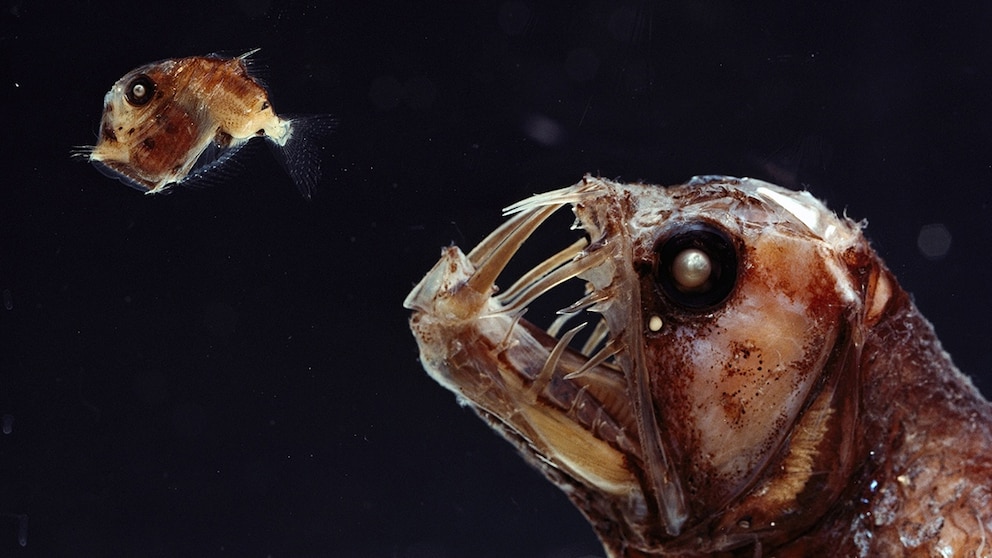May 12, 2025, 9:38 am | Read time: 5 minutes
How do fish survive in the extreme conditions of the deep sea—amid icy cold, darkness, and immense water pressure? A genomic study provides surprising answers: A single mutated gene might have widespread effects across the deep sea. Additionally, traces of human activity are found even in the ocean’s deepest trench.
Humans know more about the moon than the deep sea—and correspondingly little about the animals in the Mariana Trench, the deepest point on Earth. This is not only because space exploration has long been prioritized, but also because studying this extreme environment requires specialized technology: At depths of up to 11,000 meters, pressure ranges from 1,070 to 1,100 bar.
How much is that? An African elephant bull weighs about 5,000 kilograms. Standing on one square meter, it generates about 0.5 bar of pressure. To simulate conditions in the Mariana Trench, you would need at least 2,140 elephants stacked per square meter.
Animals in the Mariana Trench Can Withstand Pressure from 2,140 Elephants
The deep sea is one of Earth’s most extreme and least explored ecosystems—with enormous pressure, cold, and darkness. When and how fish conquered this habitat is still not fully understood. Three fundamental hypotheses circulate in the scientific literature regarding colonization:
- that the deep sea was uninhabited before the Cretaceous period,
- that it was colonized multiple times anew, and
- that some fish groups used it as a refuge during mass extinctions.
Researchers have now taken up these models in their study and analyzed the actual colonization history using genome data. It turns out that some fish lineages—such as those from the eel family—may have lived in the deep sea before the Cretaceous-Paleogene extinction. Other groups, including today’s Hadal fish at the bottom of the Mariana Trench, appeared later—parallel to the geological formation of deep fissures in the Earth’s crust.
Previous studies also suggested that the concentration of trimethylamine oxide (TMAO), a pressure-stabilizing substance, increases linearly with depth—a central tenet of deep-sea research. However, the newly published study also casts doubt on this assumption. At the same time, the focus was on the question of which genetic changes enable fish to remain functional at pressures of up to 1,100 bar.
Notable Mutation Discovered in Deep-Sea Fish
An international research team led by Han Xu, Chengchi Fang, and Shunping He (Chinese Academy of Sciences) has decoded the genomes of deep-sea fish. The study was published in March 2025 in the journal “Cell.” All examined species come from depths of 1,218 to 7,730 meters—and also live in the Mariana Trench, the deepest point on Earth.
The study is based on genome analyses of eleven deep-sea inhabitants and a shallow-water fish as a reference. Samples were collected during several expeditions with manned submersibles from depths of up to 7,730 meters. Complete genomes of dragonfish, viperfish, snailfish, and anglerfish were sequenced and then compared with genome data from 95 other fish species.
Chemical analyses of muscle and liver tissues also provided insights into the composition of TMAO, betaines, fatty acids, heavy metals, and organic pollutants. The study was conducted according to ethical guidelines and supported by several government funding programs.
Also interesting: The 7 creepiest deep-sea fish
Fish Below 3,000 Meters Showed Mutation
Researchers found a mutation that occurred in almost all fish species below 3,000 meters depth. Here, rtf1 is a central transcription factor—the process by which genetic information is transcribed into RNA. Laboratory experiments showed that this mutation also changes the transcription rate in human cells—presumably an adaptation to pressure and cold. However, not nearly as extreme as in deep-sea fish.
It was also noteworthy that the TMAO concentration in muscle tissue did not, as previously assumed, increase linearly with depth. Fish at depths over 6,000 meters sometimes showed lower TMAO values than species from mid-depths. This contradicts the long-accepted hypothesis that TMAO alone compensates for deep-sea pressure.
Environmental Toxins Have Already Reached the Deepest Point of the Ocean
Additionally, a high content of polyunsaturated fatty acids (such as DHA and EPA) was detected in deep-sea fish. The genomes also showed expanded gene families for antioxidant and membrane formation processes. Alarmingly, in the tissues of all examined animals—even in the Hadal zone of the Mariana Trench—persistent environmental toxins such as polychlorinated biphenyls (PCB) and polybrominated diphenyl ethers (PBDE) were found.
PCBs are groups of synthetic chlorine-containing industrial chemicals that were previously used in coolants, transformers, paints, and sealants. PBDEs were used as flame retardants in plastics, furniture, textiles, and electronic products.
In Germany, their replacement has been banned since the 1980s. Both groups of substances are very persistent, fat-soluble, and highly bioaccumulative—meaning they accumulate in the food chain. Additionally, they are difficult to break down and detectable in animal tissues worldwide—even in the Arctic and now the deep sea.

Turtle sets a new diving record

Ghostly new shark species discovered in the deep sea

Giant Squid Filmed Alive for the First Time — and It’s Tiny!
Animals in the Mariana Trench Need to Be Better Understood
The study provides comprehensive genetic evidence for the first time that deep-sea fish—regardless of their lineage—share a common mutation. This suggests convergent evolution, triggered by environmental factors such as pressure and temperature. This adaptation could be crucial for understanding how biological processes function under extreme conditions.
Thus, the study offers key insights into deep-sea biology and shows how molecular adaptations open new evolutionary paths. It fundamentally changes the previous understanding of TMAO as the main factor in pressure adaptation. At the same time, it provides a genetically based timeline for the colonization of the deep sea by fish—and shows that adaptation to extreme depth developed multiple times independently.
And: Even at the deepest point on Earth, humans are present—in the form of toxic residues. Further studies must now clarify whether there are ecological consequences of pollution in this unique habitat—and how it can be better protected. 1

